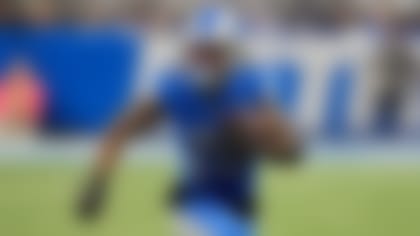Super Bowl LVI's in the books, ending the longest season in NFL history. How did the new guys perform in the expanded 285-game slate? Gennaro Filice and Nick Shook are taking a division-by-division look at each team's rookie class, providing grades and analysis on Year 1 production. Filice examines the NFC West below.
Round 1
- (No. 3) Trey Lance, QB, 6 games/2 starts
Round 2
- (48) Aaron Banks, OG, 9 games/0 starts
Round 3
- (88) Trey Sermon, RB, 9 games/2 starts
- (102) Ambry Thomas, CB, 12 games/5 starts
Round 5
- (155) Jaylon Moore, OT, 7 games/3 starts
- (172) Deommodore Lenoir, CB, 13 games/2 starts
- (180) Talanoa Hufanga, S, 15 games/3 starts
Round 6
- (194) Elijah Mitchell, RB, 11 games/10 starts
When the 49ers aggressively traded up from No. 12 to No. 3 one month before the 2021 NFL Draft, they sent a clear message to the football-watching world: Jimmy Garoppolo isn't good enough. When San Francisco used that pick on Lance, I provided a cocksure take for the NFL.com-reading world: Jimmy G's just keeping the seat warm until the rookie's inevitable takeover. Oh, and I simultaneously hit Mac Jones with a stray, ridiculing anyone who believed the Niners could have vaulted up the board to take the "high-floor guy." So ... anybody got a recipe for humble pie?
Now, I still believe in Lance's immense upside in Kyle Shanahan's offense. While his limited play was uneven, he still displayed a rocket arm and powerful running ability -- a combination that has allowed Josh Allen to climb into rarefied quarterbacking air. And even though I jumped the gun on predicting Lance would take the reins in 2021, San Francisco must pull the trigger in 2022. Because this past season's playoffs underscored the original notion: Jimmy Garoppolo isn't good enough.
San Francisco's next two picks failed to deliver much of anything in Year 1, as Banks played just five offensive snaps and Sermon was basically inexistent outside of three games. To his credit, though, 49ers GM John Lynch made hay outside of the top 100. As a matter of fact, his best pick was his last pick. Mitchell rose to the top of San Francisco's injury-riddled backfield and, despite dealing with health setbacks of his own, set a franchise rookie record with 963 rushing yards. Limited to just 11 games, he maximized each carry by averaging a healthy 4.7 yards a pop. Of the three defensive backs Lynch added to a secondary that, admittedly, remains a work in progress, Thomas provided the most intriguing returns. Burnt to a crisp in his first half-dozen games, the 22-year-old rebounded and really came on down the stretch. "He's definitely made a believer out of me the second half of this season," Shanahan said of the rookie corner in January. "I wouldn't have believed it the way it started off. It sounds harsh. But it took time. When he got his opportunity, he was ready and showed what's in him."
Round 1
- (No. 16) Zaven Collins, LB, 17 games/6 starts
Round 2
- (49) Rondale Moore, WR, 14 games/7 starts
Round 4
- (136) Marco Wilson, CB, 14 games/13 starts
Round 6
- (210) Victor Dimukeje, OLB, 14 games/0 starts
- (223) Tay Gowan, CB, 2 games/0 starts (w/ PHI)
Round 7
- (243) James Wiggins, S, 3 games/0 starts
- (247) Michal Menet, C, 0 games
Steve Keim clearly has a thing for freaky linebacker prospects. For the second straight year, the general manager eschewed bigger needs to spend his first-round pick on a 'backer with rare physical traits. Unfortunately, for the second straight year, hype exceeded reality. Like Isaiah Simmons in 2020, Collins struggled to get consistent snaps in Year 1. And that's despite the fact that Arizona basically handed Collins a starting job immediately following the draft, with Keim telling incumbent MLB Jordan Hicks he could seek a trade in May. Ultimately, Hicks was not dealt. In fact, the veteran ended up logging the most snaps on the Cardinals' defense. Collins began the year as a starter, but that didn't last long. Over the final 11 games of the season, including Arizona's postseason one-and-done, Collins played a grand total of 67 defensive snaps. Defensive coordinator Vance Joseph pointed to a Week 8 shoulder injury slowing down the rookie, but he remained active every week and logged routine special teams snaps. The more likely explanation is that Collins, like Simmons, just didn't transition into the pro game as seamlessly as Cardinals brass had hoped. Now, Simmons did start every game in Year 2, playing all over the field and stuffing the stat sheet with 105 tackles, seven passes defensed, four forced fumbles, 1.5 sacks and one pick. Maybe Collins can provide a similar jump in production next season.
The Cardinals' second and third selections each played more snaps the first-rounder, providing mixed results. Moore flashed the electric open-field ability that made him a freshman sensation at Purdue. But he also missed the last three games of the regular season with an ankle issue, calling to mind the myriad leg injuries that marred his final two collegiate campaigns. Meanwhile, Wilson was forced into the starting lineup after Malcolm Butler hit the reserve/retired list in August due to a personal matter, and the 22-year-old corner wound up starting 14 games, including the playoff loss. A spectacular athlete coming out of Florida, Wilson was still available late in the fourth round due to his unrefined technique. That showed up in Year 1, as Pro Football Focus had him allowing a 73.2 completion rate and 134.1 passer rating in coverage.
Round 2
- (No. 57) Tutu Atwell, WR, 8 games/0 starts
Round 3
- (103) Ernest Jones, LB, 15 games/7 starts
Round 4
- (117) Bobby Brown, DT, 10 games/0 starts
- (130) Robert Rochell, CB, 11 games/5 starts
- (141) Jacob Harris, TE, 9 games/0 starts
Round 5
- (174) Earnest Brown IV, DE, 0 games
Round 7
- (233) Jake Funk, RB, 10 games/0 starts
- (249) Ben Skowronek, WR, 14 games/1 start
- (252) Chris Garrett, OLB, 1 game/0 starts
Something tells me Les Snead's not gonna lose any sleep over this grade. That shiny new Lombardi Trophy completely validates the general manager's unique handling of draft currency, succinctly explained by the motto slapped on his T-shirt for the Rams' championship parade: "F--- them picks." Only he spelled it out -- and rightfully so. When you win a Super Bowl after boldly zigging in a world of zagging, let your expletive flag fly! All that said, I'm here to do a job, and that job is to grade L.A.'s rookie returns in Year 1. If the inhabitants of Rams House want me to f--- off for raining on their parade, I totally get it.
Los Angeles only had one top-100 pick in last year's draft, spending it on a speedy wideout with serious size concerns. Atwell, who stood 5-foot-8 7/8 and an eyebrow-raising 155 pounds at his pro day, managed just 10 offensive snaps before suffering a season-ending shoulder injury. He was unremarkable as a kick/punt returner and wasn't even targeted as a receiver. Not ideal. Fortunately, Snead scooped up a keeper with the Rams' other Day 2 pick. Jones stepped into the starting lineup after L.A. traded Kenny Young in late October. The rookie took the opportunity and ran with it, playing quality football in the second half of the season. Although a Week 16 ankle injury sidelined Jones for a month, he returned to the starting lineup in the Super Bowl and provided his most impactful effort yet on football's biggest stage. Remember Cincinnati's early failed fourth-and-1 attempt at midfield? That was Jones on the pass breakup. And pretty late in the third quarter, Cincinnati had the football with a four-point lead. Then Jones absorbed Joe Mixon's cut block, stayed on his feet and sacked Joe Burrow, ultimately stalling the drive.
Outside of Jones, Rochell and Skowronek were the only other Rams rookies to eclipse 29 scrimmage snaps on the season. Rochell showed promise in spurts as an outside cover man, but spent the last few months of the season on injured reserve with a chest issue. Skowronek was basically a core special teamer until injuries ravaged L.A.'s pass-catching group, pressing the seventh-rounder into (largely forgettable) action down the stretch. Everyone gets a ring, though, so I'll let myself out of this blurb.
Round 2
- (No. 56) D'Wayne Eskridge, WR, 10 games/0 starts
Round 4
- (137) Tre Brown, CB, 5 games/3 starts
Round 6
- (208) Stone Forsythe, OT, 10 games/0 starts
Notable Undrafted Free Agent
- Jake Curhan, OT, 15 games/5 starts
With a league-low three picks in the 2021 draft, this Seahawks class was fighting an uphill battle from Day 1. And then injuries hit, leveling the limited sources of joy. Eskridge, Seattle's only pick in the first two days of the draft, missed much of the offseason ramp-up due to a nagging toe injury. He was active for the season opener, but suffered a concussion and missed the next seven games. All in all, he played 10 games and posted a grand total of 14 touches for 123 yards. With Eskridge being one of the oldest players in this entire rookie class -- he turns 25 in March -- the lost season hurts even more. Brown's rookie campaign had to be the biggest gut punch of them all, though. After starting the season on injured reserve with a knee sprain, the cornerback made his NFL debut in Week 6 and immediately provided positive returns in an area of extreme need. One month later, he suffered a season-ending patellar tendon injury. In the aftermath, Pete Carroll publicly revealed that Brown had dealt with a long-term knee issue going back to at least his college days. Forsythe, Seattle's final pick, played just 14 offensive snaps on the season.
This rookie group's most positive development, form stem to stern, was the found money of an undrafted free agent. Curhan, who probably would have been selected if not for the possible heart condition that popped up in medical testing, capably started the final five games of the season at right tackle. While pass pro remains a work in progress for the 6-6 bookend, he's a road grader in the ground game. Curhan played a big part in RB Rashaad Penny's torrid close to the season.
Follow Gennaro Filice on Twitter.
















